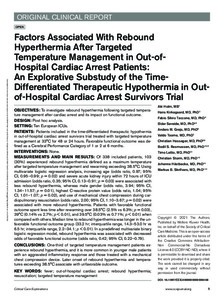Factors Associated With Rebound Hyperthermia After Targeted Temperature Management in Out-of-Hospital Cardiac Arrest Patients: An Explorative Substudy of the Time-Differentiated Therapeutic Hypothermia in Out-of-Hospital Cardiac Arrest Survivors Trial
Taccone Fabio Silvio; Hassager Christian; Holm Aki; Toome Valdo; Laitio Timo; Søreide Eldar; Storm Christian; Skrifvars Markus B.; Kirkegaard Hans; Hästbacka Johanna; Rasmussen Bodil S.; Grejs Anders M.
https://urn.fi/URN:NBN:fi-fe2022021519226
Tiivistelmä
OBJECTIVES:
To investigate rebound hyperthermia following targeted temperature management after cardiac arrest and its impact on functional outcome.
DESIGN:
Post hoc analysis.
SETTING:
Ten European ICUs.
PATIENTS:
Patients included in the time-differentiated therapeutic hypothermia in out-of-hospital cardiac arrest survivors trial treated with targeted temperature management at 33°C for 48 or 24 hours. Favorable functional outcome was defined as a Cerebral Performance Category of 1 or 2 at 6 months.
INTERVENTIONS:
None.
MEASUREMENTS AND MAIN RESULTS:
Of 338 included patients, 103 (30%) experienced rebound hyperthermia defined as a maximum temperature after targeted temperature management and rewarming exceeding 38.5°C. Using multivariate logistic regression analysis, increasing age (odds ratio, 0.97; 95% CI, 0.95–0.99; p = 0.02) and severe acute kidney injury within 72 hours of ICU admission (odds ratio, 0.35; 95% CI, 0.13–0.91; p = 0.03) were associated with less rebound hyperthermia, whereas male gender (odds ratio, 3.94; 95% CI, 1.34–11.57; p = 0.01), highest C-reactive protein value (odds ratio, 1.04; 95% CI, 1.01–1.07; p = 0.02), and use of mechanical chest compression during cardiopulmonary resuscitation (odds ratio, 2.00; 95% CI, 1.10–3.67; p = 0.02) were associated with more rebound hyperthermia. Patients with favorable functional outcome spent less time after rewarming over 38.5°C (2.5% vs 6.3%; p = 0.03), 39°C (0.14% vs 2.7%; p < 0.01), and 39.5°C (0.03% vs 0.71%; p < 0.01) when compared with others. Median time to rebound hyperthermia was longer in the unfavorable functional outcome group (33.2 hr; interquartile range, 14.3–53.0 hr vs 6.5 hr; interquartile range, 2.2–34.1; p < 0.01). In a predefined multivariate binary logistic regression model, rebound hyperthermia was associated with decreased odds of favorable functional outcome (odds ratio, 0.42; 95% CI, 0.22–0.79).
CONCLUSIONS:
One-third of targeted temperature management patients experience rebound hyperthermia, and it is more common in younger male patients with an aggravated inflammatory response and those treated with a mechanical chest compression device. Later onset of rebound hyperthermia and temperatures exceeding 38.5°C associate with unfavorable outcome.
Kokoelmat
- Rinnakkaistallenteet [19207]
